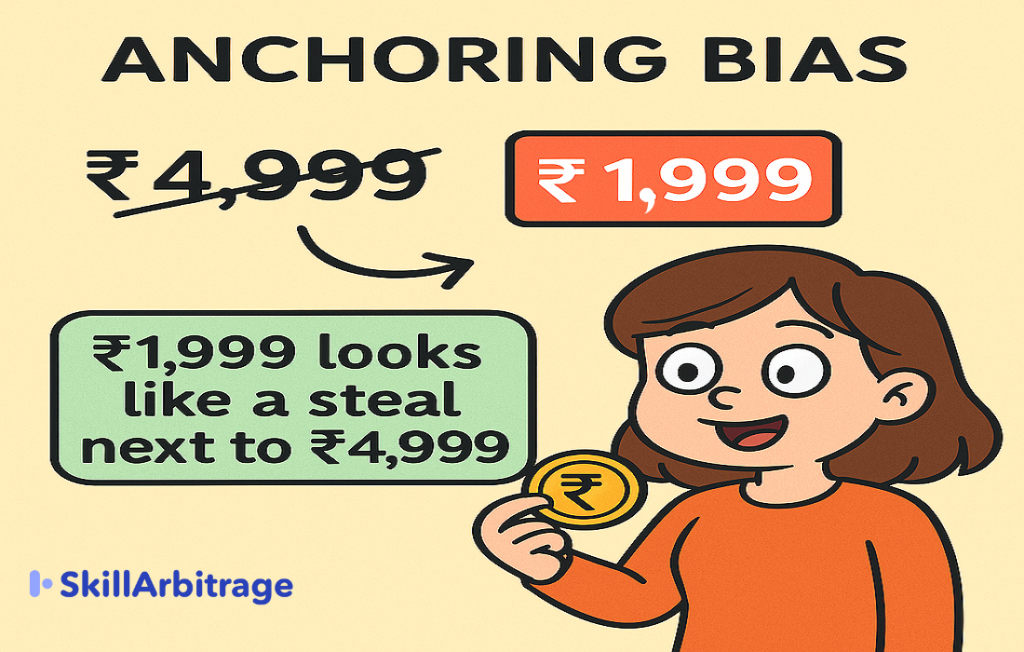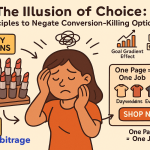This blog decodes anchoring bias and tells you how you can implement it. It would be useful for content writers, marketers, and strategists who want to use this super strategy to drive conversions faster.
Table of Contents
Introduction
I was out shopping with a friend, and afterward, we decided to get a coffee, to go over our purchases, rest our tired legs, and justify overpriced purchases to each other. This was an essential part of every girls-only shopping session.
Over her hazelnut latte, my friend explained to me that she actually won by buying a ₹ 2,000 dress not originally on her list. According to Girl Math, this was a win because the dress was originally priced at ₹ 2,999, and she bought it at a special offer. Businesses use this exact strategy to rake in revenue.
Has it ever happened to you?
Have you ever gone to buy a kurta or a dress for ₹999 and returned feeling victorious because it was “originally ₹3,299”?
You’re not alone. This is not a coincidence. This is a strategy.
A psychological playbook that many Indian businesses have mastered, often without anyone realizing it.
The phenomenon behind this? Anchoring bias.
A recent study found that anchoring can increase perceived value by up to 30%, even when discounts are modest.
Anchoring isn’t just a pricing trick; it’s a deep-rooted cognitive bias that warps how we perceive value. One number, the first we see, becomes the ‘anchor’.
Everything else we see feels like a bargain, even if the final price is still quite high.
And this effect is more powerful than most businesses realize.
Today, let’s unpack this bias through the lens of Indian e-commerce, edtech, and fitness apps, and I will show you how to ethically and effectively use anchoring to boost conversions, drive upgrades, and build perceived value into every product.
What is Anchoring Bias?
Anchoring bias refers to the human tendency to rely heavily on the first piece of information (the anchor) we receive when making a decision.
In pricing, that anchor is typically the original or highest price shown to us.
Let’s say you see a pair of running shoes that cost ₹4,999. You balk at the price. Then you see another pair marked ₹1,999 with a strikethrough from ₹4,999. Now ₹1,999 doesn’t feel expensive anymore. It feels like a win.
That’s anchoring.
The key? The original number doesn’t even need to be “real.” If the brand sets the anchor high enough and consistently enough, your brain will automatically compare everything against it.
The benefits of using anchoring bias are that it can pack a lot of value for a brand. Look at this infographic.
It is obvious why brands would prefer selling something at a markedly lower price.
We see this at play on most days. Here are the most common examples.
Why ₹1,999 looks like a steal beside ₹4,999
Let’s break this down using real-world examples.
1. Delivery apps
Delivery apps often run membership plans. Swiggy has the “One Membership Plan” and Dunzo once ran a campaign offering a “₹249/month Dunzo Plus membership”, with a “regular” monthly price of ₹599 struck out.
Here’s what’s happening:
- ₹599 sets the anchor.
- ₹249 suddenly feels not just cheap — but like a loss if ignored.
- Even though the average Dunzo user might not need the plan, the perceived savings justify the purchase.
The anchoring effect turns a maybe into a confident yes.
2. Gym pro tier
Gyms like CultFit offer multiple tiers of fitness subscriptions:
- Pro: ₹599/month
- Black: ₹2,499/month (with added benefits)
- Elite: ₹4,999/month
By first presenting you with Elite (₹4,999), suddenly Cult Black (₹2,499) seems affordable, even premium, but within reach.
That’s the decoy effect + anchoring.
You might never consider ₹2,499/month for home workouts… until you see ₹4,999 first.
3. EdTech strikethroughs that convert
Upskilling platforms like Unacademy, upGrad, or SkillArbitrage use anchoring with laser precision. You will often find one course with multiple prices on offer.
Like this:
- Course MRP: ₹49,999
- Your Price: ₹14,999
- Offer valid for 48 hours only
Without saying anything else, the copy makes you feel like:
- You’re getting a ₹35,000 benefit
- The opportunity is rare (scarcity trigger)
- Delay means loss
They’ve combined anchoring + scarcity + urgency — and that’s a deadly conversion cocktail.
Why this works (and why it’s not going away)
Anchoring works because the human brain thinks in contrast, not in absolutes.
You rarely ask: “Is this objectively worth ₹1,999?”
Instead, you think, like my friend, “It was ₹4,999. Now it’s ₹1,999. That’s huge!”
Your brain gets tricked into focusing on the difference instead of the value.
And when this is combined with emotional urgency (like limited-time discounts), our decision-making skips logic entirely. We go wild to purchase that one item, which we might not even need.
How to apply anchoring in your brand’s pricing strategy
Ready to weaponize this bias for your brand ethically?
Here’s a breakdown.
1. Start with a high anchor (then strike it out)
Even if your actual price is ₹2,999, show it against a high anchor like ₹5,999 but only as a limited-time offer like a festival or a weekend sale.
Make sure the anchor is believable (or you risk trust issues).
Example: “MRP ₹5,999 | Now ₹2,999 | Save ₹3,000!”
2. Use decoy pricing
Follow the gym membership pattern and set a multi-tier pricing range.
Offer 3 packages like this:
- Starter: ₹999
- Pro: ₹1,999
- Premium: ₹4,999
Most people will choose Pro. It makes sense and feels like a better value than Starter while being significantly cheaper than Premium.
That’s the decoy effect in action. Pro becomes the ‘smart choice’, even if it has the best margins for you.
3. Offer bundle anchors
Want to sell a ₹499 course? Make it part of a bundle worth ₹4,999 and then offer it as a standalone free reward. The bundle drives the perceived value of the product higher, making the standalone seem even more tempting.
“This ₹499 course is part of our ₹4,999 bundle. Yours free if you enroll now.”
Boom. The course now has a perceived value way above ₹499.
Use solo pricing to anchor, and bundles to upsell.
4. Always show “you save ₹X”
Rather than just showing discounts or wanting people to do the math themselves, make it easier by telling people exactly what they’re saving. This quantifies the gain and anchors their benefit.
Example:
“Save ₹3,000 today!” hits harder than just “60% off”.
5. Use urgency to reinforce anchoring
Pair a high anchor with limited-time pricing to drive instant purchases.
Example:
“Course Price: ₹19,999
Now: ₹5,999
Only for the first 100 seats.”
This does three things. It sets a high anchor, offers dramatic savings, and adds urgency (scarcity).
Here’s a recap of the entire process:
Anchoring ≠ lying: How to use it ethically.
A word of caution.
Don’t fake MRP or create fake discounts. Not only is it against the law in India, but italso desperately hurts consumer trust.
If your product was never priced at ₹4,999, don’t pretend it was. The long-term cost of lost trust is far more damaging than a short-term sale.
Use anchoring to frame real value, not manufacture imaginary discounts.
Brands that use it well (think Nykaa, Mamaearth, SkillArbitrage, Wakefit) anchor based on real prices and transparent promotions.
Final word: anchor value, not just price
Anchoring isn’t just a psychological trick. It’s a valuable communication tool.
When used ethically, it helps you show people what they’re getting, in context. It makes your product easier to understand, compare, and buy.
The first number your customer sees defines their entire buying experience. So don’t leave it to chance.
Craft it. Frame it. Control it.
Because if you don’t anchor your value, someone else will, and it may not be in your favour. Try out these anchoring techniques for your products and drop me a comment to let me know how it went.
FAQs
Q1: Can anchoring work in B2B pricing too, or is it only a B2C strategy?
Absolutely. In fact, anchoring is hyper-effective in B2B where budgets are often pre-approved.
For instance, an agency might show:
- Custom Website: ₹2,50,000
- E-commerce Suite: ₹1,50,000
- Basic Website: ₹70,000
Even if the client only needed a basic site, ₹70,000 feels cheap in context. Plus, it creates space for value-based upselling.
Q2: Will repeating the same anchor price in every sale reduce its effectiveness over time?
Yes — this is called anchor fatigue. If every “sale” always shows the same original price and same discount, users start treating it as the default price, not a deal.
To avoid this:
- Change anchors by campaign
- Mix formats (₹ off vs % off)
- Introduce time-sensitive bonuses instead of static price cuts
Q3: Does anchoring work in high-trust, high-involvement categories like education or health?
Surprisingly, yes — if it’s used transparently.
In edtech, showing a ₹75,000 mentorship program discounted to ₹39,999 only works if:
- The anchor price has existed before
- The value is clearly broken down (mentors, calls, hours, access, etc.)
Without clear value, it backfires. Use content (breakdowns, testimonials) to justify the anchor.
Q4: Can anchoring work without showing strikethrough prices?
Definitely. Strikethroughs are just a visual signal. But anchoring can also be verbal or narrative.
Example:
“Most students pay ₹3,000/month for coaching. Our self-paced plan gives you the same for ₹999/month.”
Or:
“Comparable skincare serums cost ₹2,499+. Our direct-to-consumer model brings it to you for ₹699.”
No strikeout. Still anchored.
Q5: How do you combine anchoring with freemium or free trials? Isn’t the anchor ₹0?
Smart question.
In freemium models, anchor the premium plan, not the free one.
Say:
“Upgrade to Premium for ₹299/month (worth ₹799/month). Cancel anytime.”Now ₹799 becomes the anchor. ₹299 feels affordable. Even if the user started at ₹0, they now see the upgrade as value, not loss.







 Allow notifications
Allow notifications
